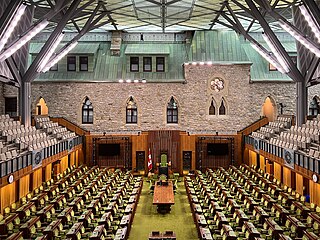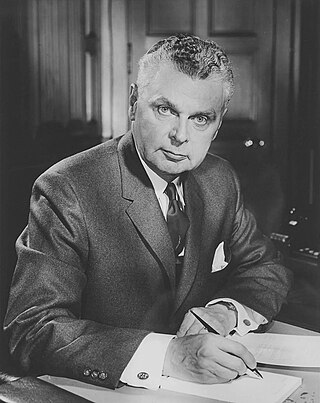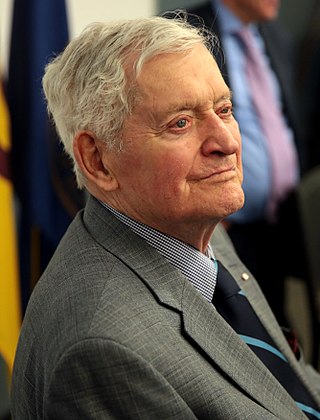This article needs additional citations for verification .(October 2015) |
 |
|---|
The Canadian electoral system is based on a parliamentary system of government, modelled on that of the United Kingdom.
This article needs additional citations for verification .(October 2015) |
 |
|---|
The Canadian electoral system is based on a parliamentary system of government, modelled on that of the United Kingdom.
The Parliament of Canada consists of:
Elections Canada is the non-partisan agency responsible for the conduct of elections in Canada, including federal elections, by-elections and referendums. It is headed by the chief electoral officer.
Representation in the House of Commons is based on electoral districts, also known as constituencies or ridings. Each riding elects one member to the House of Commons, and the number of ridings is established through a formula set out in the constitution.
Riding boundaries are established by independent commissions, and take into account:
New commissions are set up every ten years to make any necessary revisions to existing boundaries, following criteria defined in the Electoral Boundaries Readjustment Act . The process of redefining electoral boundaries is called "redistribution", and the results are recorded in a "representation order". The Representation Order of 2003 set the number of ridings at 308. The 2012 redistribution set the number of ridings to 338.
Canada's electoral system, sometimes referred to as a "first-past-the-post" system, is formally referred to as a single-member plurality system. The candidate with the most votes in a riding wins a seat in the House of Commons and represents that riding as its member of Parliament (MP). The governor general asks the leader of the party whose candidates have won the most seats to form a government; that leader becomes prime minister. The party whose candidates win the second largest number of seats becomes the Official Opposition. That party gets more finances and prestige than the other opposition parties.
An absolute majority of the votes cast in the last election is not needed to have power, and is rarely achieved. As well, the party in power does not need to have a majority of seats in the House of Commons – and under the current multi-party system, quite often does not have that. However to pass bills, the governing party must have support of a majority of MPs. Without majority support, the government falls and a new party is named government or an election has to be held. Four parties have achieved power at the federal level in Canada's history – the original Conservatives, the Liberals, the Progressive Conservatives and the modern Conservatives.
Voter turnout fell dramatically between 1962 (79%) and 2011 (61.4%). The Gallagher Index of disproportionality for Canadian federal elections in that period has ranged from 6.26 to 20.91, in line with some of its comparables — Australia, New Zealand (prior to adoption of MMP in 1992) and United States (presidential electoral college), but significantly higher than many others, for example Belgium, Germany, Ireland, United States (House) and the Scandinavian countries. [1]
Voter turnout rose higher in 2015 to 68.5%, and to 66% in 2019.
Historically, the prime minister could ask the governor general to call an election at virtually any time, although one had to be called no later than five years after the return of the writs under section 4 of the Canadian Charter of Rights and Freedoms . In 2007, the Conservative Parliament passed an act requiring fixed election dates in Canada every four years. [2] This law does not curtail the power of the governor general to dissolve Parliament at any time, as was done for the 2008 election at the request of Prime Minister Stephen Harper.
If a government loses a confidence motion, traditionally the prime minister will ask the governor general to call an election. The governor general when approached by the prime minister who has lost a vote of confidence will traditionally call an election. However, it is not assured as some assume. The governor general also has the right to call the leader of the party they think would be most likely to be able to form a government and ask them if they can form the government. This happened in 1926 and is referred to as the King-Byng Affair.
Any number of candidates may run for election in an electoral district, but each candidate may only run in one district, either independently or under the banner of a political party. Each party may endorse only one candidate per riding. Candidates who run for election without party affiliation may be designated as independent or as having no affiliation.
A political party is a group of people who together:
To obtain the right to put the party name on the ballot, under the names of the candidates it endorses, a political party must register with the chief electoral officer. As of 2022 [update] , there were 22 registered political parties operating at the federal level in Canada.
After an election, the party with the most elected representatives usually becomes the governing party. The leader of this party is then summoned by the governor-general and sworn in as Prime Minister of Canada shortly after the election concludes. The party with the second largest number of MPs is called the Official Opposition. Each of the elected candidates has a seat in the House of Commons, where they debate and vote on draft legislation (called bills) and thus attempt to have an influence on government policy. A party having a majority of the seats can pass what it wants despite any opposition from the group(s) holding the minority of seats, but the imperative to be re-elected and any moral pressure the opposition can impose may temper its legislative agenda
All citizens (18 years and older) have the right to a voice in choosing their parliamentary representatives. Canada's electoral law requires the chief electoral officer to inform the public about the system and about individual rights under that system and to remove obstacles that may make voting difficult for some.
During an election, Elections Canada informs Canadians about their right to vote, how to get on the National Register of Electors and the voter's list, and where and how they can vote. Its public information activities include
Between elections, the agency publishes additional background information for the public, keeps its telephone enquiries centre and website open to answer questions, and works with educators to encourage young people to vote when they become eligible (18 years and older).
Helping to remove obstacles to voting is an important part of Elections Canada's work. Voters who are not able to vote on polling day can vote at the advance polls. A mail-in special ballot is available for Canadians who are away from their ridings, travelling or temporarily resident overseas. Even Canadians in their own ridings during the election period may use the special ballot if they do not wish to go to a polling station. In special cases, electors with a disability may vote at home, in the presence of an election officer. Mobile polls serve voters living in certain institutions, such as nursing homes for people who are elderly or who have a disability.
Wherever possible, election officers at polling stations speak both official languages (English and French). In addition, a deputy returning officer can appoint and swear in an interpreter to help communicate with a voter.
All votes are made on the same standard heavy paper ballot, which is inserted in a standard cardboard box, furnished by Elections Canada. The ballot and the box are devised to ensure that no one except the elector knows the individual choice that was made.
As of 2021 [update] Prime Minister Justin Trudeau was in favour of adopting a ranked voting system also referred to as instant-runoff voting or preferential voting. [3]
Trudeau promised electoral reform in the 2015 campaign but was unable to get a consensus with the other political parties. He did not implement electoral reform, saying all parties were not in agreement. Each party had different suggestions, one or more even wanting to stick to first past the post.[ citation needed ]

The House of Commons of Canada is the lower house of the Parliament of Canada. Together with the Crown and the Senate of Canada, they comprise the bicameral legislature of Canada.
Primary elections, or direct primary are voting processes by which voters can indicate their preference for their party's candidate, or a candidate in general, in an upcoming general election, local election, or by-election. Depending on the country and administrative divisions within the country, voters might consist of the general public in what is called an open primary, or solely the members of a political party in what is called a closed primary. In addition to these, there are other variants on primaries that are used by many countries holding elections throughout the world.

The 1867 Canadian federal election was held from August 7 to September 20, 1867, and was the first election for the new country of Canada. It was held to elect members representing electoral districts in the provinces of Nova Scotia, New Brunswick, Ontario and Quebec to the House of Commons of the 1st Canadian Parliament. The provinces of Manitoba (1870) and British Columbia (1871) were created during the term of the 1st Parliament of Canada and were not part of this election.
Canada holds elections for legislatures or governments in several jurisdictions: for the federal (national) government, provincial and territorial governments, and municipal governments. Elections are also held for self-governing First Nations and for many other public and private organizations including corporations and trade unions. Municipal elections can also be held for both upper-tier and lower-tier governments.

The 1917 Canadian federal election was held on December 17, 1917, to elect members of the House of Commons of Canada of the 13th Parliament of Canada. Described by historian Michael Bliss as the "most bitter election in Canadian history", it was fought mainly over the issue of conscription. The election resulted in Prime Minister Sir Robert Borden's Unionist government elected with a strong majority and the largest percentage of the popular vote for any party in Canadian history.

The 2006 Canadian federal election was held on January 23, 2006, to elect members to the House of Commons of Canada of the 39th Parliament of Canada.

The 2008 Canadian federal election was held on October 14, 2008, to elect members to the House of Commons of Canada of the 40th Canadian Parliament after the previous parliament had been dissolved by Governor General Michaëlle Jean on September 7, 2008.
The Politics of British Columbia involve not only the governance of British Columbia, Canada, and the various political factions that have held or vied for legislative power, but also a number of experiments or attempts at political and electoral reform.

The Province of Manitoba, similar to other Canadian provinces and territories, is governed through a Westminster-based parliamentary system. The Manitoba government's authority to conduct provincial affairs is derived from the Constitution of Canada, which divides legislative powers among the federal parliament and the provincial legislatures. Manitoba operates through three branches of government: the executive, the legislative, and the judicial. The executive branch—the Government of Manitoba—consists of the Executive Council and the Premier, who is the head of government and the President of the Executive Council. The legislative branch—the Manitoba Legislature—is composed of the Lieutenant Governor and the Legislative Assembly, which is composed of the 57 members (MLAs) elected to represent the people of Manitoba, as well as the Speaker, the Clerk, the Officers of the Legislative Assembly, and the employees of the legislative service.
Electoral reform is a change in electoral systems which alters how public desires are expressed in election results.

There are five types of elections in the United Kingdom: elections to the House of Commons of the United Kingdom, elections to devolved parliaments and assemblies, local elections, mayoral elections, and police and crime commissioner elections. Within each of those categories, there may also be by-elections. Elections are held on Election Day, which is conventionally a Thursday, and under the provisions of the Dissolution and Calling of Parliament Act 2022 the timing of general elections can be held at the discretion of the prime minister during any five-year period. All other types of elections are held after fixed periods, though early elections to the devolved assemblies and parliaments can occur in certain situations. The five electoral systems used are: the single member plurality system (first-past-the-post), the multi-member plurality, the single transferable vote, the additional member system, and the supplementary vote.
The 42nd Canadian federal election was held on October 19, 2015. The incumbent Conservative Party of Canada of Prime Minister Stephen Harper, in office since 2006, was defeated by the Liberal Party of Canada under the leadership of Justin Trudeau. The Liberals rebounded from third place in the House of Commons with 36 seats to a strong majority government with 184 of the 338 seats in the expanded Commons. The Liberals picked up 148 seats, easily the biggest numerical increase for a Canadian party since Confederation.

This article is the electoral history of William Lyon Mackenzie King, the tenth Prime Minister of Canada. A Liberal, he was Canada's longest-serving prime minister, with three separate terms as prime minister, for a total of 21 years and 154 days. He defeated Prime Ministers Arthur Meighen and R.B. Bennett at different times, and was succeeded by Prime Minister Louis St. Laurent in 1948.

This article is the Electoral history of John Diefenbaker, the thirteenth Prime Minister of Canada.

This article is the Electoral history of Pierre Trudeau, the fifteenth Prime Minister of Canada.

This article is the Electoral history of John Turner, the seventeenth Prime Minister of Canada.

This article is the Electoral history of Kim Campbell, the nineteenth Prime Minister of Canada.
This article is the Electoral history of Stephen Harper, the twenty-second prime minister of Canada. Harper served as prime minister from February 6, 2006 to November 4, 2015, having won three general elections.
This article is the Electoral history of Justin Trudeau, the twenty-third and current Prime Minister of Canada. Trudeau has served as prime minister since November 5, 2015, having won three general elections.

The 2021 Canadian federal election was held on September 20, 2021, to elect members of the House of Commons to the 44th Canadian Parliament. The writs of election were issued by Governor General Mary Simon on August 15, 2021, when Prime Minister Justin Trudeau requested the dissolution of parliament for a snap election.